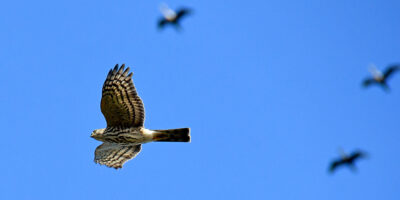
You’re at a hawk watch and the birds overhead have found the thermals, circling higher and lower – occasionally flapping. They dont look anything like the pictures in your field guide that shows them perched close up. In fact, sometimes it’s even difficult to get any field mark other than a silhouette as they are so backlit from the sun at midday. Is it possible to identify flying raptors just from the way look from below and the way they fly? Absolutely!
First, start with being able to recognize the different raptor shapes:
- Eagles are overall our largest raptor species. Bald Eagles, once on the Endangered Species list, are now the most commonly seen raptor. They are easy to identify from below as they look like a flying cross – huge bird, super long flat wings, and wide tail. Not much flapping is needed here and these eagles will soar very high.
- Vultures may look a lot like hawks in flight, but most of their flight patterns are different and they are larger than most hawks. Turkey Vultures are easily identifiable in flight because they fly like they are a little tipsy and off balance with their wings in a V shape. California Condors, on the other hand, are just plain enormous with a 10-foot wingspan. So, while eagles in general are our biggest raptors, any bird you see with a wide wingspan of 10 feet in North America is going to be a condor.
- Buteos are the largest hawks in North America. Compared to other hawks, they are thicker, have short wide tails, and broad, rounded wings. They include birds like Red-tailed Hawks and Broad-winged Hawks. These birds will soar a lot with their thick wings.
- Accipiters like Cooper’s or Sharp-shinned Hawks are thinner, have longer legs and tails, and shorter wings than buteos. Many are forest dwellers and have an innate agility to speed through the branches of a forest after prey.
- Falcons from smaller and more colorful American Kestrels to large, dark Peregrine Falcons have thinner, more sharply shaped wings to cut through the air. The smaller falcons like Kestrels will flap a lot and not look like they have a real direction in mind. But their larger cousins, Peregrines are solidly built for stamina and speed, and race past like they are on a mission.
Check out this article from Audubon with more tips about identifying flying raptors.
Migrating Hawks: Photo Credit: Deborah Rivel